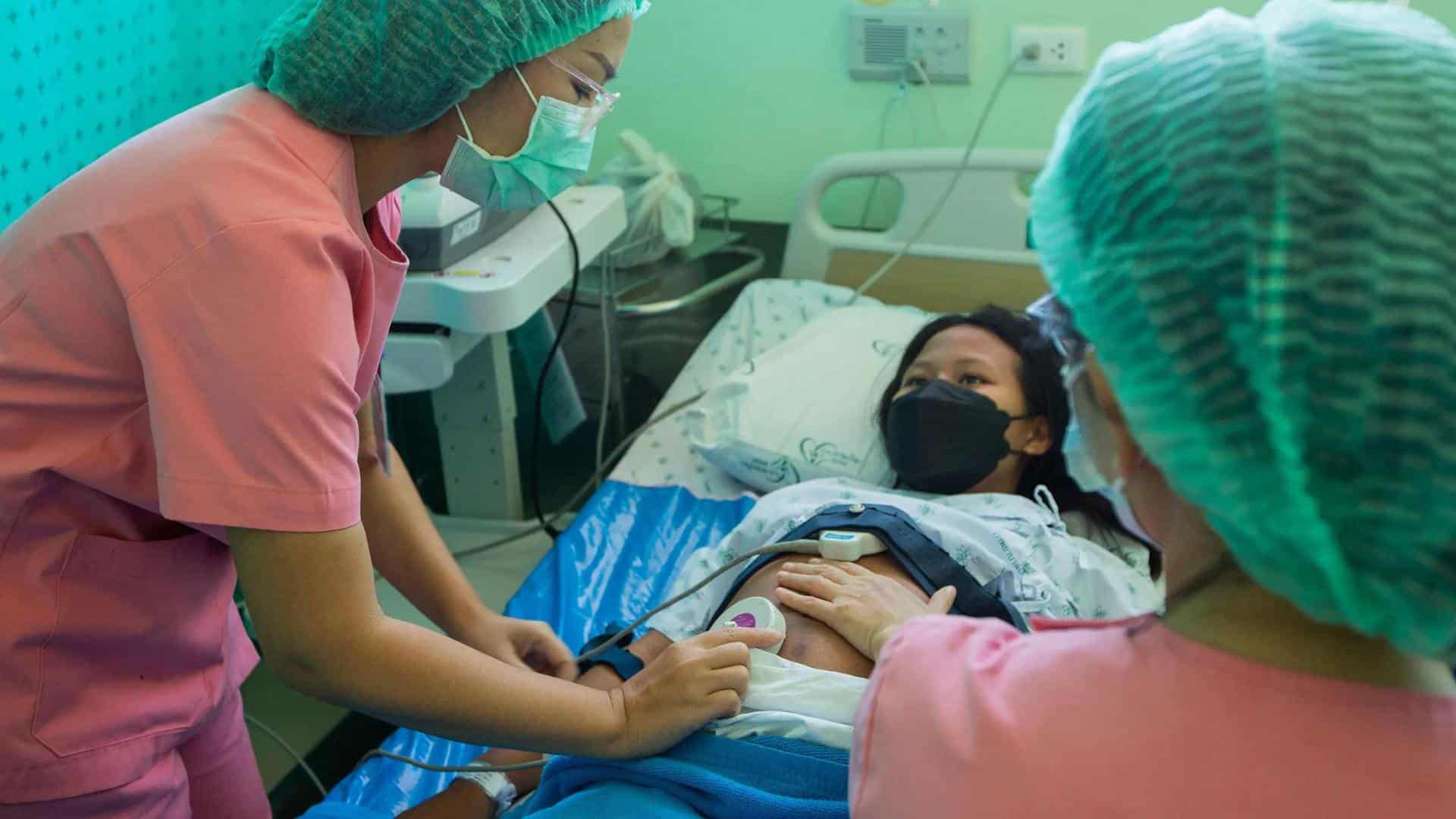Across cultures and times, midwives have been at the side of women, helping bring healthy babies into the world. Finally, the world recognizes their value.

Midwife Sifa Ndeze attends to mother and baby. (Credit: UNFPA DRC/Junior Mayindu)
Call them “baby catchers,” grannies or birth attendants, the midwife has been the bridge to life for newborns since the dawn of time.
There to assist birthing moms from the Queen of Sheba to the future Queen of England, from hippies and flower children to soccer moms, the universal practice that once got its pioneers burned at the stake was given great honor by UNESCO on 6 December 2023 in Botswana.
Eight countries sponsored a successful resolution that adds midwifery to UNESCO’s List of Intangible Cultural Heritage of Humanity. Midwifery joins a long line of inherited knowledge and practices such as traditional Thai massage and Jamaican reggae music.
“UNESCO has confirmed what midwives and women have known for millennia — midwives are a core part of the human experience, present across all cultures and geographies,” said the International Confederation of Midwives, applauding the recognition.
As a midwife, witnessing births is a highlight in my life.
The vital role midwives play
But the birth of a baby is just a small part of midwifery. The human connection with families sustains me as it does my colleagues. Midwives bear witness to the journey from pregnancy into the postpartum period, for people from all walks of life.
But for many, keeping up with the challenges of the healthcare system is no longer sustainable and it saddens me when I see colleagues leave the profession.
Midwives attend birth in many countries, but their services and expertise are utilized in some countries more than others. In Scandinavian countries most babies are born with assistance from midwives. In the UK, policies connect each pregnant person with a midwife and, in 2019, appointed England’s first Chief Midwifery Officer. However, only 12% of moms in the United States and 13% of those in Canada gave birth with midwives.
There are almost two million midwives around the world. But according to the United Nations Population Fund, that reflects a worldwide shortage of these vital health care providers. A 2021 report found that millions of neonatal deaths and stillbirths could be prevented were more midwives trained, particularly in low-income countries.
An undervalued player in the health system
C. J. Blennerhassett, midwife and president of the Canadian Association of Midwives welcomes the recognition from UNESCO, but stressed that society will only benefit from the full power of midwives to change health outcomes when the profession is involved in framing and influencing health decisions.
The value and growth of the profession will be most felt where midwives are incorporated into leadership, Blennerhassett said. “And the clinician is not just valued but the perspective of the profession, and the expertise and the skill that midwifery brings to the health system is recognized,” she said.
Despite its universality, the profession has often been under threat even as it has been deeply woven into the fabric of society.
Arts and culture depict tensions around health, sexuality and family life — with midwives often at the centre. Despite relentless prosecution, skills and knowledge have passed on, giving historians a glimpse into women’s experiences. Remnants of age-old debates persist to current day social norms and health practices.
Debates about sexual morality, chastity, marriage and preservation of life continue around the world, with varying impact on access to health care and social stigma.
Midwives across cultures
The people of ancient Egypt, Greek and Rome highly regarded the skills and knowledge of midwives. Biblical verses describe midwives being commanded by Pharoah; their leadership preserved for centuries.
Midwifery expertise thrived in medieval Spain, where female healers were popular as midwives, but also as physicians. Nobles would employ midwives for the life-long care of royal families.
Today, midwifery and nursing continue to be female-dominated professions. The physician workforce is increasingly female, with research that the ‘tend and befriend’ approach leads to better outcomes.
Inequities in compensation in gendered work remain social problems in a variety of cultures.
Popular fiction from authors Emma Donoghue, Lawrence Hill, Lisa See and Ami McKay depict pressures midwives face in their community. The memoirs of midwife Jennifer Worth inspired the BBC drama Call the Midwife, with season 13 starting in the new year.
Accounts from court cases can be found, from the trial of enigmatic Agondice in 400 BCE, a woman who disguised herself as a man to learn and care for women in ancient Athens, to Jacobina Felice in 1322, a female healer in Paris who grew in popularity for her skills.
Lore passed down through the ages
Midwifery continued during the spread of witch hunts in the Western world. At the end of the Ottoman Empire, bans and prosecution for abortion care extended to all midwives: Armenian, Greek, Jewish and Muslim.
Despite the best care, not all births result in healthy babies. Obstetrics has become highly litigious for all health care providers. When malpractice cases involve midwives, the cases get sensationalized, renewing public misinformation around the profession of midwifery and its role in supporting community health.
The vast knowledge amassed by midwives through the ages has evolved into today’s training. But its mysterious origins continue to puzzle historians.
Soranus of Ephesus, a physician in Ancient Greece wrote a textbook on midwifery. His teachings passed on over centuries with excerpts have been found in Europe and in East Asian translations.
From medieval to modern medicine
Women’s knowledge, as that found in the textbook, Trotula, became widely used in medical education. In the 1700s, the King of France tasked midwife Madam du Coudray to train students across France.
In the process of sharing her knowledge and working to reduce mortality, she developed life-sized teaching models, pre-dating the simulation labs found in medical schools across the globe. This overlapped with Elizabeth Nihell in London, who authored the Treatise on the Art of Midwifery, sparking debates amongst healers on the use and safety of forceps in childbirth.
Debates around best practices continue as new research emerges. For instance, a recent study highlights the risks of vacuum or forceps in delivery.
Midwifery-led research develops best practices in health, including when compared to physician care. Standard textbooks of today are complemented with online sources of information from infographics, clinical practice guidelines and workshops and seminars.
The range of midwifery cultures blend and evolve in urban and rural life alike. Birth work retains components of pre- and post-legislation midwifery and variation in employment and training models.
The joy of bringing babies into the world
I might bump into clients and their families at the supermarket. Driving through different neighbourhoods, l remember past clients. Midwives tease each other about receiving calls with questions, years after people have had their babies. Informal networks across communities help families looking for healthcare options. Residents passing birth centres are reminded of the unassuming work that carries on the human race each day. Birth stools, depicted in ancient images of births, continue supporting an upright position in labour. These too have had small tweaks in designs through the years.
Public perceptions of midwifery vary, depending on cross-cultural representation, such as if people come from countries where midwifery is common. Teachings and experiences, from Granny midwives in the United States, Pateras in Latin America and Indigenous midwives kept cultural knowledge alive.
“Indigenous midwives are not just about catching babies. We are nutrition. We are breastfeeding. We are safety in remote areas. We are insurance for our young families,” says Carol Couchie, Nishnawbe Midwife and Mentorship Lead at the National Council of Indigenous Midwives.
Midwives keep passing the history on to the next generation of midwives, with greater attention to equity, racism and inclusion.
For instance, Karline Wilson-Mitchell, midwifery professor at Toronto Metropolitan University, has been studying the exclusion of racialized midwives in Canada and documenting findings in the Colour of Birth project. A virtual gallery is dedicated to highlighting these ‘relics to racism’. Work from artists like painter Amanda Greavette and poet Kayla Q and influencers on social media evoke the ups and downs of present day midwifery. The internet has made it easier to share and pass on information, along with establishing new traditions and connections amongst midwives.
Midwife Ginger Fram finds Greavette’s paintings especially moving. “There is one where the viewer only sees the midwives’ hand palpating the belly,” Fram said. “I know those hands personally and it helped me to become the midwife I wanted to be and passed that passion and teaching to my students.”
The reminders are the same: to keep using your heart, your head and your hands.
Questions to consider:
- Why did UNESCO decide that midwifery was important to the world’s cultural heritage?
- In what ways have societies misunderstood the role of midwives?
- Why might someone want a midwife to handle a birth rather than a physician?

Ayeshah Haque is a Canadian midwife and a Fellow in Journalism and Health Impact at the University of Toronto.
